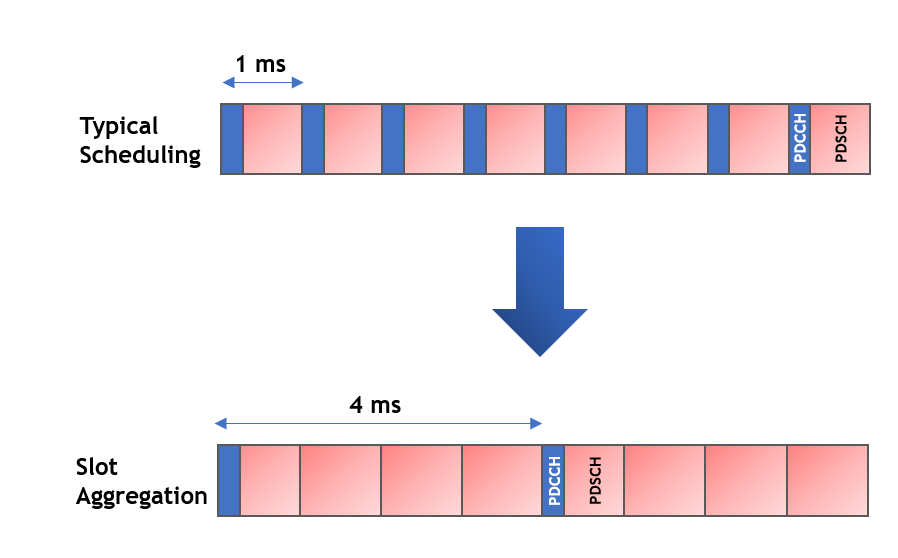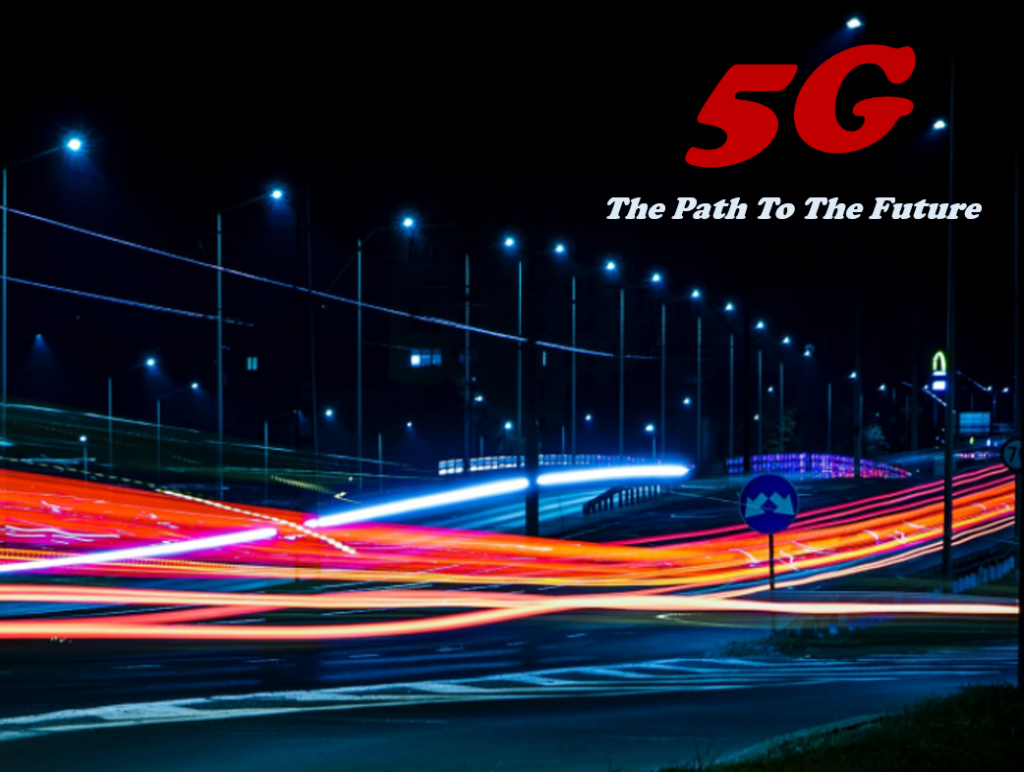This article discusses the enhancements in spectral efficiency and scheduling algorithms introduced in the 5G NR specifications. The increase in spectral efficiency due to various features and scheduling algorithms ensures that 5G can have higher throughput compared to its predecessors. So, lets discuss the various enhancements that make such high data rates possible.
Slot Aggregation:
In 4G, each TTI has two main parts – PDCCH and PDSCH. The PDCCH carries the control and scheduling information while the PDSCH carries the data or traffic. The UE reads the PDCCH which tells the UE where its data is located on the PDSCH. Usually, a 4G subframe consists of 14 symbols and PDCCH can utilize 3 of these 14 symbols which is around 20% overhead. The advanced PDCCH algorithms reduce this overhead by reducing the control symbol utilization but still PDCCH has to exist in every subframe and therefore, its overhead is always there.

However, 5G introduces a concept of slot aggregation where it is not mandatory to have PDCCH in all TTIs. The main idea is that the gNB has the downlink data in its buffer so it knows the amount of bits that are present or atleast it can estimate the incoming bit rate for a specific UE. So, if the UE has a significant amount of data then the gNB can assign a PDCCH that allocates multiple slots to that UE. So, the UE will read the PDCCH and it will find out that the PDCCH has assigned 5 slots or TTIs to the UE including the first one. Then, it will read all the 5 slots and there will be no PDCCH from 2nd slot onwards. This means that from 2nd slot onwards, the overhead of PDCCH will be zero and all the symbols will be used to transmit data increasing the capacity and spectral efficiency of the system.
F-OFDM:
The concept of inherent guard band has been revolutionized in 5G. The current 4G technology uses a guard band of approximately 10%. This can be seen by the fact that a 10 MHz 4G channel has 50 RBs and each RB has 12 subcarriers. So, this gives us a total of 600 subcarriers per 10 MHz 4G channel. As each subcarrier has a spacing of 15 kHz, so these 600 subcarriers will take a total of 9000 kHz or 9 MHz. This shows that in a channel of 10 Mhz, only 9 MHz is utilized while around 1 MHz is left as a guard band. In 5G, enhanced techniques like F-OFDM are used which lets 5G use much more bandwidth and as can be seen a total of 275 RBs can be used in 50 MHz. For 4G, only 250 RBs are used with a 50 MHz spectrum. This provides another gain in the spectral efficiency of 5G.
CRS Free Transmission:
The concept of CRS is pretty important in 4G as UEs use the CRS to estimate the channel. However, the CRS are being transmitted continuously in 4G which results in significant downlink interference. 5G eliminates the usage of CRS as it tries to minimize signals that are always active. In 5G, the user specific DMRS will be used which means that each user will have its own RS within its allocation and if there is no allocation then there will be no RS. This will reduce the overall interference in the system and will increase the average CQI. An increase in CQI means an increase MCS and spectral efficiency.
This approach raises a question for cell selection and reselection process as UEs use the CRS during these processes in 4G to estimate a RSRP and to choose the best cell. If these signals are not present then the UE will not be able to get an accurate RSRP for the cell during selection or reselection process. However, in 5G, the SSB which is the PSS/SSS/PBCH block will always be transmitted at regular intervals and this block will have its own RS which might be used for the UE for the sake of this initial selection or reselection. Later on, once it gets its own allocations, it will get its own UE specific RS so there should be no issue.
Code Block Groups:
I explained this in my previous article but since it is related to spectral efficiency as well so I will summarize it again. 5G NR introduces a concept of Code Block Groups (CBGs) which will essentially divide the transport blocks in smaller groups. These groups will be decoded by the UE and the UE will send HARQ feedback for each of the individual groups. The advantage of this approach is that since 5G will be supporting huge Transport Block Sizes (TBS) and the scheduler usually works with a 10% BLER target so this means that if the gNB is transmitting data to a UE with huge TBS, around 10% of this data will be retransmitted. However, if the transport block is divided into subsets – let’s assume 3 subsets – then the UE will send NACK for only the failed subset and the gNB will only need to retransmit the failed subset instead of the whole transport block. This can effectively reduce the overhead of retransmissions and improve the spectral efficiency. On the other hand, this requires an increase in HARQ feedback overhead, as previously, the UE will only send a single bit feedback for one transport block but now it will need to send multiple bits of feedback for each CBG inside the transport block. This overhead is reduced by implementing an adaptive CBG structure such that it is enabled or disabled by the gNB whenever required. So, the gNB can activate CBGs if the TBS is huge but it can deactivate the CBGs and fall back to the original TBS if the TBS is small as then the overhead of retransmission will also be tolerable.
Channel Coding:
A new coding mechanism is introduced for 5G. The eMBB will use Low Density Parity Check (LDPC) codes which have much higher efficiency than the current turbo codes. The simulations show that the gain of LDPC increases with higher transport blocks. That is why control traffic which does not use huge transport blocks will not use LDPC. Consequently, a different set of codes are introduced for control traffic and they are known as Polar Codes. These are relatively newer codes and the only codes which boast that they can achieve the shannon capacity if the decoding SC list set is big enough. In the current simulations, these codes are bound to provide around 0.5 dB gain over the current turbo codes. So, the coding enhancements will also provide significant gain in both the data and control plane.
How 5G Has Better Spectral Efficiency?
In case of any queries or feedback, please drop a comment below and I would love to respond and help. Also, if this has been helpful, then please subscribe to our Youtube channel – Our Technology Planet for more exciting stuff and videos.
Ali Khalid
Latest posts by Ali Khalid (see all)
- 5G Coverage Expansion Analysis – Find The Optimal 5G Coverage Threshold For Your Network - November 9, 2024
- 5G Coverage Expansion - November 9, 2024
- 5G SA Cell Search & Network Entry Matrix - July 18, 2023

Your posts stand out from other sites I’ve read stuff from. Keep doing what you’re doing! Here, take a look at mine Article Sphere for content about about SEO.
is there any actual difference in terms of user through put of 20Mhz channel of 5G and LTE? Any visible change in terms of peak throughput achieved by 20Mhz of 5G over 20 Mhz of LTE?
No, if the bandwidth is same then there is not a significant difference between 5G and 4G. For instance, if both of them are using 20MHz channel, then 5G will have around 5 to 7% more capacity compared to 4G.
Nice article , short and sweet .
Very useful for beginners for quick understandings.
Thanks Praveen
can you tell us about guard band in 5G ?
in lte, we have 10% of the bandwidth lost as guard. is it the same in 5g?
For 5G, it would be less than 4%.
mashalla, its very useful article.
wishing you all the best bro
Thanks for this very good write up for 5G beginners. It helped me a lot. I would request if possible please include some quantitative examples, related to each chapter. Hoping for more like this one, in days to come. Thanks again.
Sure, stay tuned 🙂
Very interesting article. Actually the CRS free transmission concept is beginning to be implemented in 4G as well, with “Lean Carrier” features.
Agreed, Ericsson goes with lean carrier while Huawei includes it under eMIMO features as coordinated pilot scheduling but there are many chipsets that have compatibility issues with these features at the moment.
CRS Free Transmission:
1. RS in its own allocation means that RS symbol will be present with in the RBs scheduled ? and is there count of it since RS symbols are fixed in LTE Resource Grid
2. Suppose UE is in RRC Connected Mode but is not allocated any Resource and it is moving so how measurements will pan out specially in case of Handover
3. With 2T or 4T , we have RS DTX on all Antenna Ports except one at moment of the time so what will be the scenario here?
4. In case of high PRB Usage , scenario will be similar to LTE that interference will not be minimized and this will work better in lower load cases?
Yeah, RS will be present in the locations where the user data is allocated. So, the approach will be user specific reference signals. The measurements can work based on MIB based reference signals. 5G will have massive mimo and beam-forming so conventional 2T and 4T approaches are not applicable. Regarding high PRB usage, you are right.
so either it is cell selection/re-selection or handover , measurements will be based on MIB reference signals always when User Specific Reference Signals are not available , right ?
So the count of RS symbols will not be fixed then on what basis count of RS symbols will be determined since they will not be transmitting any User Data so the number of User Specific Reference Signals may make a difference
Any idea about this?
F-OFDM :
Can you provide some details on F-OFDM that how it is reducing the guard band
I am assuming by 275 RBs in 50 MHz , additional 10 RBs with 20 MHz and 5 RBs with 10 MHz
so additional 5 RBs (10 MHz) => 5 * 12 = 60 sub carriers and 60*15kHZ = 0.9 MHz
Utilizing 9,9 MHz instead of 9 MHz , is it correct
I will recommend you to study the paper on 5G waveforms on Rhode & Schwarz. This should clarify all answers and also gives an insight in other options in 5G like FBMC and UFMC.
Can you provide the link ?
And is the understanding regarding the calculation is correct?
Very nice article .Keep sharing the stuff.
Just have below query regarding article and information.
1) CBG feedback consume more resource in uplink for HARQ , how about CBG adaptive information to UE, will it via reconfig ?
2) How about LDPC coding rate for Throughput calculation ? As turbo coding is having 3/4 rate for 4G calculation (Although it is depend on MCS selection )
3) As you mention about Reference signal for DL channel quality estimation (Cell reselection and mobility). It will be very useful if you can write article on physical channel as there are many DMRS associated with PSS/SSS/ESS/CSI/PBCH in 5G.
Yeah the CBG is supposed to be dynamic. For LDPC, there is a very good explanation of gain with TBS over Turbo codes on Qualcomm website. I will recommend you to go through that.